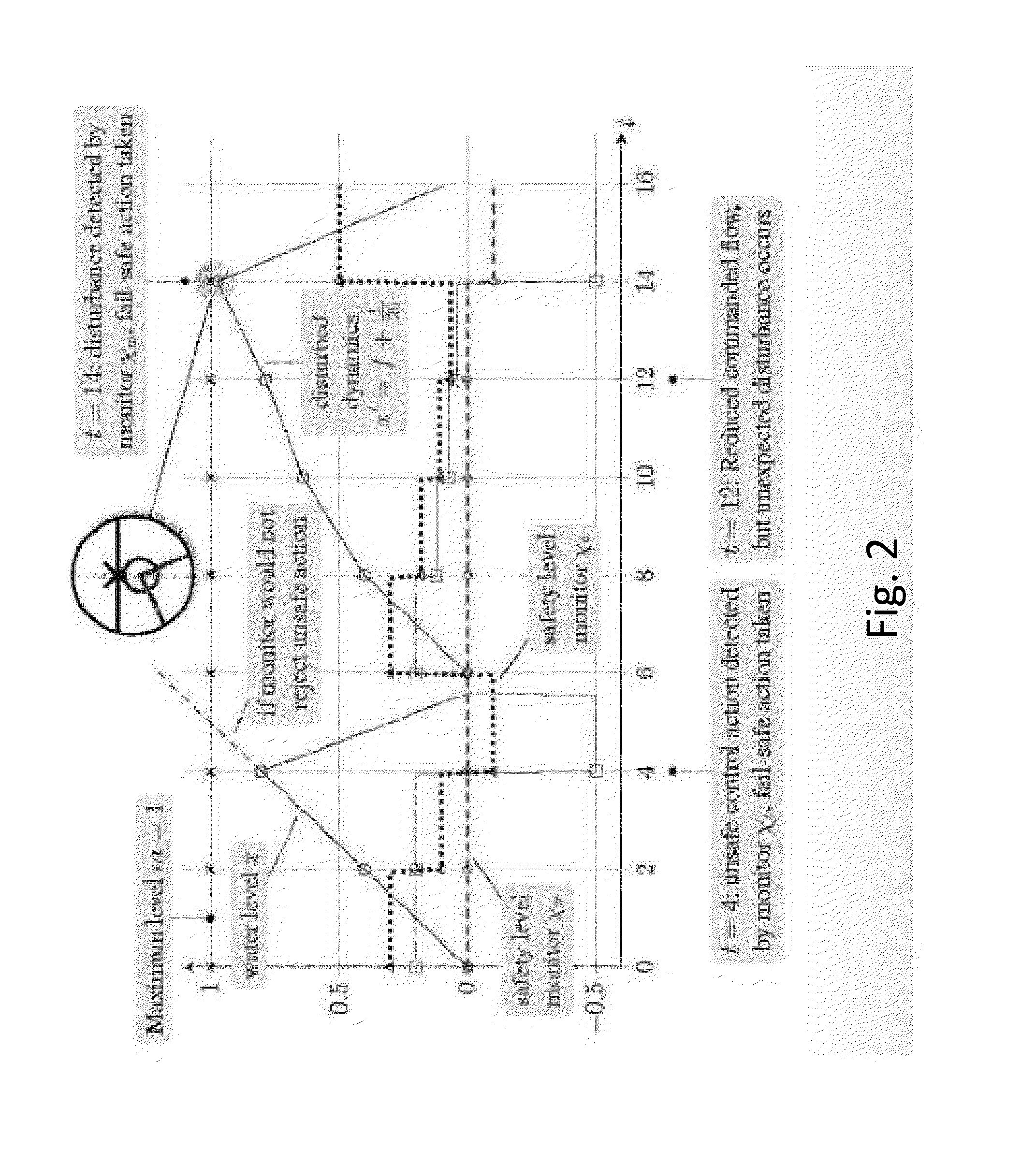Verified Runtime Validation of Verified Cyber-Physical System Models
a cyber-physical system and verification runtime technology, applied in the field of cyber-physical systems, can solve problems such as inability to guarantee safety and potentially unsafe systems
- Summary
- Abstract
- Description
- Claims
- Application Information
AI Technical Summary
Benefits of technology
Problems solved by technology
Method used
Image
Examples
example 1
[0039]A simple water tank is used as a running example to illustrate the concepts throughout this section. The water tank has a current level x and a maximum level m. The water tank controller, which runs at least every ε time units, non-deterministically chooses any flow f between a maximum outflow −1 and a maximum
m-xɛ.
This water tank never overflows, as witnessed by a proof for the following dL formula.
0≤x≤m⋀ɛ>0φ→[(f:=*;?(-1≤f≤m-xɛ);t:=0;(x′=f,t′=1&x≥0⋀t≤ɛ))*](0≤x≤m)φ
ModelPlex Monitor Synthesis
[0040]This section introduces the nature of ModelPlex monitor specifications, the approach in this invention for generating such specifications from hybrid system models, and how to turn those specifications into monitor code that can be executed at runtime along with the controller.
[0041]A ModelPlex specification 104 corresponds to the formula (2). If the current state of a system does not satisfy a ModelPlex specification 104, some behavior that is not reflected in the model 100 oc...
example 2
[0050]The specification conjecture for the water tank model is given below. It is constructed from the model by removing the loop, flipping the modality, and formulating the specification requirement as a property, since we are interested in a relation between two consecutive states v and w (recalled by x+, f+ and t+). Using theorem proving, we analyze the conjecture to reveal the actual monitor specification 104.
ɛ>0φlowest→〈f:=*;?(-1≤f≤m-xɛ);t:=0;(x′=f,t′=1&x≥0⋀t≤ɛ)〉(x=x*⋀f=f*⋀t=t*)ϒVm+
[0051]Use theorem proving to analyze the specification conjecture. The proof rules of dL are used to analyze the specification conjecture xm. These proof rules syntactically decompose a hybrid model 100 into easier-to-handle parts, which leads to sequents with first-order real arithmetic formulas towards the leaves of a proof. Using real arithmetic quantifier elimination we close sequents with logical tautologies, which do not need to be checked at runtime since they always evaluate to true fo...
example 3
[0058]The corresponding steps in the water tank proof use * for the nondeterministic flow assignment (f:=*) and ∃r to instantiate the resulting existential quantifier ∃F with a new logical variable F (plant is an abbreviation for x′=f, t′=1&0≦xt≦ε). The proof without and with application of Opt. 1 is given as.
[0059]Next, differential equations are handled. Even when the differential equation can be solved, existentially and universally quantified variables remain. Inspect the corresponding proof rule from the dL calculus. For differential equations it must be proven that there exists a duration t, such that the differential equation stays within the evolution domain H throughout all intermediate times {tilde over (t)} and the result satisfies φ at the end. At this point there are three options:
[0060]i. Option 1: instantiate the existential quantifier, if it is known that the duration will be t+;
[0061]ii. Option 2: introduce a new logical variable, which is the generic case that alwa...
PUM
 Login to View More
Login to View More Abstract
Description
Claims
Application Information
 Login to View More
Login to View More - R&D
- Intellectual Property
- Life Sciences
- Materials
- Tech Scout
- Unparalleled Data Quality
- Higher Quality Content
- 60% Fewer Hallucinations
Browse by: Latest US Patents, China's latest patents, Technical Efficacy Thesaurus, Application Domain, Technology Topic, Popular Technical Reports.
© 2025 PatSnap. All rights reserved.Legal|Privacy policy|Modern Slavery Act Transparency Statement|Sitemap|About US| Contact US: help@patsnap.com



